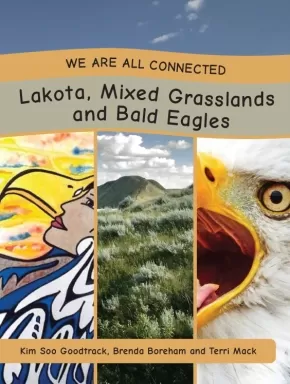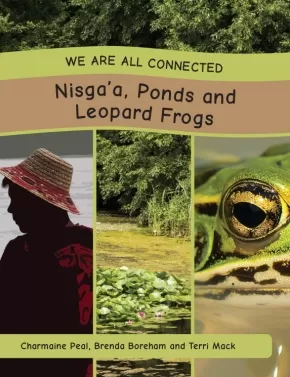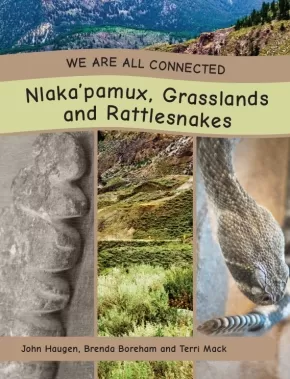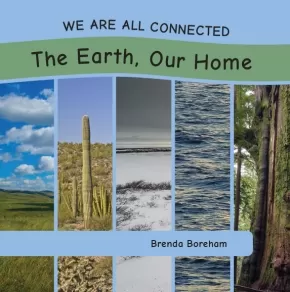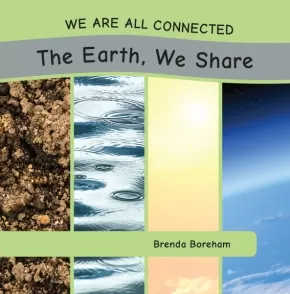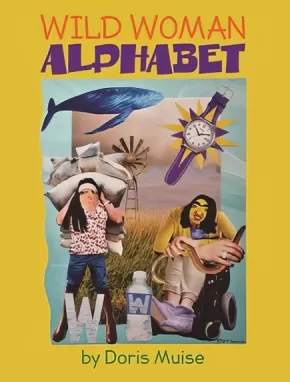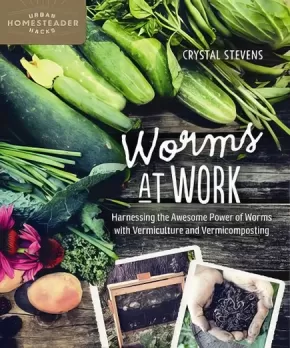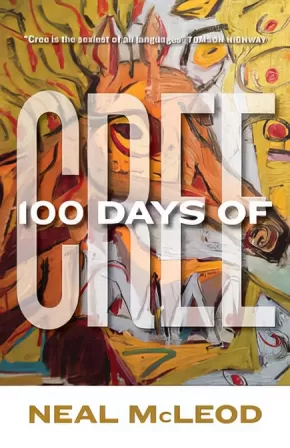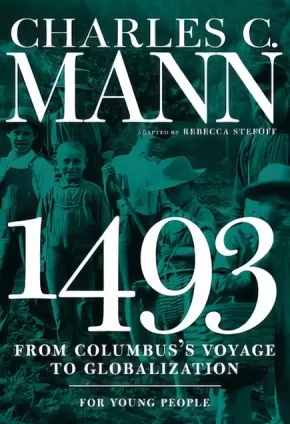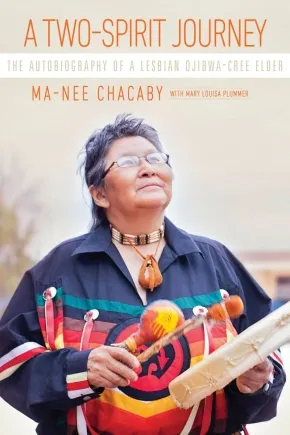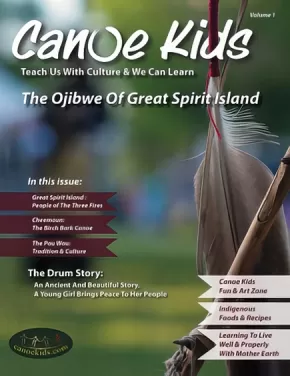
Non-Fiction
496
-
510
of
748 Results;
Sort By
Go To
of 50
We Are All Connected: Inuit, Tundra and Ravens
 $21.95
$21.95

Format:
Paperback
Text Content Territories:
Indigenous Canadian; Inuit;
ISBN / Barcode: 9781771742481
Synopsis:
Synopsis:
“We Are All Connected” is a series that explores how we all live together in a shared balance upon Mother Earth. Each book explores a specific ecosystem with a focus on one animal and its adaptations for survival within that ecosystem. Indigenous interviewees, each living within the same area, have responded to strategic questions as to how their community interacts with the land, their traditional territory. Explore each text with a sense of inquiry in mind.
8 We Are All Connected Titles Coast Salish, Coastal Rainforests and Cougars Haisla, Rivers and Chinook Salmon Inuit, Tundra and Ravens Lakota, Mixed Grasslands and Bald Eagles Métis, Wetlands and Mallards Nisga'a, Ponds and Leopard Frogs Nlaka'pamux, Grasslands and Rattlesnakes Sto:lo, Riparian Forests and Black Bears Each title covers the following curricular areas. Traditional storytelling and artwork begin each title from the focus Indigenous territory. Science: Biodiversity, classification, life cycles, food chains, food webs and connections between living and non-living things are just some of the science concepts included in each book. Social Studies: Contemporary and historical Indigenous cultural knowledge flows throughout each book. Local land forms, gatherings, harvesting practices and government are some of the social studies concepts included in each book.
2 Foundation Titles The two foundational books provide deeper understanding of the content of the “We Are All Connected” titles. We Are All Connected: The Earth, Our Home- explores biomes, ecosystems and biodiversity. We Are All Connected: The Earth, We Share- explores the interconnectedness between living and non-living things.
Authenticity Note: This title includes some Indigenous artwork and photographs, such as artwork from Tooma Laisa and Terri Mack.
Additional Information
32 Pages | 8.5" x 11" | ISBN: 9781771742481
We Are All Connected: Lakota, Mixed Grasslands and Bald Eagles
 $21.95
$21.95

Format:
Paperback
Text Content Territories:
Indigenous Canadian; First Nations; Sioux; Lakota;
ISBN / Barcode: 9781771742474
Synopsis:
Synopsis:
“We Are All Connected” is a series that explores how we all live together in a shared balance upon Mother Earth. Each book explores a specific ecosystem with a focus on one animal and its adaptations for survival within that ecosystem. Indigenous interviewees, each living within the same area, have responded to strategic questions as to how their community interacts with the land, their traditional territory. Explore each text with a sense of inquiry in mind.
8 We Are All Connected Titles Coast Salish, Coastal Rainforests and Cougars Haisla, Rivers and Chinook Salmon Inuit, Tundra and Ravens Lakota, Mixed Grasslands and Bald Eagles Métis, Wetlands and Mallards Nisga'a, Ponds and Leopard Frogs Nlaka'pamux, Grasslands and Rattlesnakes Sto:lo, Riparian Forests and Black Bears Each title covers the following curricular areas. Traditional storytelling and artwork begin each title from the focus Indigenous territory. Science: Biodiversity, classification, life cycles, food chains, food webs and connections between living and non-living things are just some of the science concepts included in each book. Social Studies: Contemporary and historical Indigenous cultural knowledge flows throughout each book. Local land forms, gatherings, harvesting practices and government are some of the social studies concepts included in each book.
2 Foundation Titles The two foundational books provide deeper understanding of the content of the “We Are All Connected” titles. We Are All Connected: The Earth, Our Home- explores biomes, ecosystems and biodiversity. We Are All Connected: The Earth, We Share- explores the interconnectedness between living and non-living things.
Authenticity Note: This work contains some Indigenous artwork and photographs throughout, such as artwork from Kim Soo Goodtrack.
Additional Information
32 pages | 8.50" x 11.00" | ISBN" 9781771742474
We Are All Connected: Métis, Wetlands and Mallards
 $21.95
$21.95

Format:
Paperback
Text Content Territories:
Indigenous Canadian; Métis;
ISBN / Barcode: 9781771742511
Synopsis:
Synopsis:
“We Are All Connected” is a series that explores how we all live together in a shared balance upon Mother Earth. Each book explores a specific ecosystem with a focus on one animal and its adaptations for survival within that ecosystem. Indigenous interviewees, each living within the same area, have responded to strategic questions as to how their community interacts with the land, their traditional territory. Explore each text with a sense of inquiry in mind.
8 We Are All Connected Titles Coast Salish, Coastal Rainforests and Cougars Haisla, Rivers and Chinook Salmon Inuit, Tundra and Ravens Lakota, Mixed Grasslands and Bald Eagles Métis, Wetlands and Mallards Nisga'a, Ponds and Leopard Frogs Nlaka'pamux, Grasslands and Rattlesnakes Sto:lo, Riparian Forests and Black Bears Each title covers the following curricular areas. Traditional storytelling and artwork begin each title from the focus Indigenous territory. Science: Biodiversity, classification, life cycles, food chains, food webs and connections between living and non-living things are just some of the science concepts included in each book. Social Studies: Contemporary and historical Indigenous cultural knowledge flows throughout each book. Local land forms, gatherings, harvesting practices and government are some of the social studies concepts included in each book.
2 Foundation Titles The two foundational books provide deeper understanding of the content of the “We Are All Connected” titles. We Are All Connected: The Earth, Our Home- explores biomes, ecosystems and biodiversity. We Are All Connected: The Earth, We Share- explores the interconnectedness between living and non-living things.
Authenticity Note: This book contains some Indigenous artwork and photos throughout, such as artwork from Leah Marie Dorion.
Additional Information
32 pages | 8.50" x 11.00" | ISBN: 9781771742511
We Are All Connected: Nisga'a, Ponds and Leopard Frogs
 $21.95
$21.95

Format:
Paperback
Text Content Territories:
Indigenous Canadian; First Nations; Nisga'a;
ISBN / Barcode: 9781771742498
Synopsis:
Synopsis:
“We Are All Connected” is a series that explores how we all live together in a shared balance upon Mother Earth. Each book explores a specific ecosystem with a focus on one animal and its adaptations for survival within that ecosystem. Indigenous interviewees, each living within the same area, have responded to strategic questions as to how their community interacts with the land, their traditional territory. Explore each text with a sense of inquiry in mind.
8 We Are All Connected Titles Coast Salish, Coastal Rainforests and Cougars Haisla, Rivers and Chinook Salmon Inuit, Tundra and Ravens Lakota, Mixed Grasslands and Bald Eagles Métis, Wetlands and Mallards Nisga'a, Ponds and Leopard Frogs Nlaka'pamux, Grasslands and Rattlesnakes Sto:lo, Riparian Forests and Black Bears Each title covers the following curricular areas. Traditional storytelling and artwork begin each title from the focus Indigenous territory. Science: Biodiversity, classification, life cycles, food chains, food webs and connections between living and non-living things are just some of the science concepts included in each book. Social Studies: Contemporary and historical Indigenous cultural knowledge flows throughout each book. Local land forms, gatherings, harvesting practices and government are some of the social studies concepts included in each book.
2 Foundation Titles The two foundational books provide deeper understanding of the content of the “We Are All Connected” titles. We Are All Connected: The Earth, Our Home- explores biomes, ecosystems and biodiversity. We Are All Connected: The Earth, We Share- explores the interconnectedness between living and non-living things.
Authenticity Note: This work contains some Indigenous artwork and photographs throughout, such as artwork and photos from Charmaine Peal.
Additional Information
32 pages | 8.50" x 11.00" | ISBN: 9781771742498
We Are All Connected: Nlaka'pamux, Dry Grasslands and Rattlesnakes
 $21.95
$21.95

Format:
Paperback
Text Content Territories:
Indigenous Canadian; First Nations; Salish; Interior Salish; Nlaka'pamux (Thompson);
ISBN / Barcode: 9781771742528
Synopsis:
Synopsis:
“We Are All Connected” is a series that explores how we all live together in a shared balance upon Mother Earth. Each book explores a specific ecosystem with a focus on one animal and its adaptations for survival within that ecosystem. Indigenous interviewees, each living within the same area, have responded to strategic questions as to how their community interacts with the land, their traditional territory. Explore each text with a sense of inquiry in mind.
8 We Are All Connected Titles Coast Salish, Coastal Rainforests and Cougars Haisla, Rivers and Chinook Salmon Inuit, Tundra and Ravens Lakota, Mixed Grasslands and Bald Eagles Métis, Wetlands and Mallards Nisga'a, Ponds and Leopard Frogs Nlaka'pamux, Grasslands and Rattlesnakes Sto:lo, Riparian Forests and Black Bears Each title covers the following curricular areas. Traditional storytelling and artwork begin each title from the focus Indigenous territory. Science: Biodiversity, classification, life cycles, food chains, food webs and connections between living and non-living things are just some of the science concepts included in each book. Social Studies: Contemporary and historical Indigenous cultural knowledge flows throughout each book. Local land forms, gatherings, harvesting practices and government are some of the social studies concepts included in each book.
2 Foundation Titles The two foundational books provide deeper understanding of the content of the “We Are All Connected” titles. We Are All Connected: The Earth, Our Home- explores biomes, ecosystems and biodiversity. We Are All Connected: The Earth, We Share- explores the interconnectedness between living and non-living things.
Authenticity Note: This title includes some authentic Indigenous photographs.
Additional Information
32 pages | 8.50" x 11.00" | ISBN: 9781771742528
We Are All Connected: Sto:lo, Riparian Forests and Black Bears
 $21.95
$21.95

Format:
Paperback
Text Content Territories:
Indigenous Canadian; First Nations; Salish; Coast Salish; Sto:lo;
ISBN / Barcode: 9781771742450
Synopsis:
Synopsis:
“We Are All Connected” is a series that explores how we all live together in a shared balance upon Mother Earth. Each book explores a specific ecosystem with a focus on one animal and its adaptations for survival within that ecosystem. Indigenous interviewees, each living within the same area, have responded to strategic questions as to how their community interacts with the land, their traditional territory. Explore each text with a sense of inquiry in mind.
8 We Are All Connected Titles Coast Salish, Coastal Rainforests and Cougars Haisla, Rivers and Chinook Salmon Inuit, Tundra and Ravens Lakota, Mixed Grasslands and Bald Eagles Métis, Wetlands and Mallards Nisga'a, Ponds and Leopard Frogs Nlaka'pamux, Grasslands and Rattlesnakes Sto:lo, Riparian Forests and Black Bears Each title covers the following curricular areas. Traditional storytelling and artwork begin each title from the focus Indigenous territory. Science: Biodiversity, classification, life cycles, food chains, food webs and connections between living and non-living things are just some of the science concepts included in each book. Social Studies: Contemporary and historical Indigenous cultural knowledge flows throughout each book. Local land forms, gatherings, harvesting practices and government are some of the social studies concepts included in each book.
2 Foundation Titles The two foundational books provide deeper understanding of the content of the “We Are All Connected” titles. We Are All Connected: The Earth, Our Home- explores biomes, ecosystems and biodiversity. We Are All Connected: The Earth, We Share- explores the interconnectedness between living and non-living things.
Authenticity Note: This book contains some Indigenous artwork and photographs, such as photos from Rod Peters and artwork from Celestine Aleck.
Additional Information
32 pages | 8.50" x 11.00" | ISBN: 9781771742450
We Are All Connected: The Earth, Our Home
 $11.95
$11.95

Format:
Paperback
ISBN / Barcode: 9781771742535
Synopsis:
Synopsis:
“We Are All Connected” is a series that explores how we all live together in a shared balance upon Mother Earth. Each book explores a specific ecosystem with a focus on one animal and its adaptations for survival within that ecosystem. Indigenous interviewees, each living within the same area, have responded to strategic questions as to how their community interacts with the land, their traditional territory. Explore each text with a sense of inquiry in mind.
8 We Are All Connected Titles Coast Salish, Coastal Rainforests and Cougars Haisla, Rivers and Chinook Salmon Inuit, Tundra and Ravens Lakota, Mixed Grasslands and Bald Eagles Métis, Wetlands and Mallards Nisga'a, Ponds and Leopard Frogs Nlaka'pamux, Grasslands and Rattlesnakes Sto:lo, Riparian Forests and Black Bears Each title covers the following curricular areas. Traditional storytelling and artwork begin each title from the focus Indigenous territory. Science: Biodiversity, classification, life cycles, food chains, food webs and connections between living and non-living things are just some of the science concepts included in each book. Social Studies: Contemporary and historical Indigenous cultural knowledge flows throughout each book. Local land forms, gatherings, harvesting practices and government are some of the social studies concepts included in each book.
2 Foundation Titles The two foundational books provide deeper understanding of the content of the “We Are All Connected” titles. We Are All Connected: The Earth, Our Home- explores biomes, ecosystems and biodiversity. We Are All Connected: The Earth, We Share- explores the interconnectedness between living and non-living things.
Additional Information
32 pages | 8.00" x 8.00" | ISBN: 9781771742535
We Are All Connected: The Earth, We Share
 $11.95
$11.95

Format:
Paperback
ISBN / Barcode: 9781771742542
Synopsis:
Synopsis:
“We Are All Connected” is a series that explores how we all live together in a shared balance upon Mother Earth. Each book explores a specific ecosystem with a focus on one animal and its adaptations for survival within that ecosystem. Indigenous interviewees, each living within the same area, have responded to strategic questions as to how their community interacts with the land, their traditional territory. Explore each text with a sense of inquiry in mind.
8 We Are All Connected Titles Coast Salish, Coastal Rainforests and Cougars Haisla, Rivers and Chinook Salmon Inuit, Tundra and Ravens Lakota, Mixed Grasslands and Bald Eagles Métis, Wetlands and Mallards Nisga'a, Ponds and Leopard Frogs Nlaka'pamux, Grasslands and Rattlesnakes Sto:lo, Riparian Forests and Black Bears Each title covers the following curricular areas. Traditional storytelling and artwork begin each title from the focus Indigenous territory. Science: Biodiversity, classification, life cycles, food chains, food webs and connections between living and non-living things are just some of the science concepts included in each book. Social Studies: Contemporary and historical Indigenous cultural knowledge flows throughout each book. Local land forms, gatherings, harvesting practices and government are some of the social studies concepts included in each book.
2 Foundation Titles The two foundational books provide deeper understanding of the content of the “We Are All Connected” titles. We Are All Connected: The Earth, Our Home- explores biomes, ecosystems and biodiversity. We Are All Connected: The Earth, We Share- explores the interconnectedness between living and non-living things.
Additional Information
32 pages | 8.00" x 8.00" | ISBN: 9781771742542
Wild Woman Alphabet
$24.95
Artists:
Format:
Hardcover
Text Content Territories:
Indigenous Canadian;
ISBN / Barcode: 9781926886480
Synopsis:
Synopsis:
"A bunch of Wild women once wandered this land and thought that their dinners had gotten too bland. They set out in search of fine foods they could get and ate up the sounds of the whole alphabet."
This quirky ABC book for older children and adults has Indigenous themes and unusual collaged illustrations. Each letter of the alphabet presents a short story designed to cover teaching objectives ranging from letter recognition, letter sounds, rhyming, word families, vocabulary, consonant blending, contractions, compound words and more.
Educator Information
Recommended for Grades K-7 for these subject areas: Art Education, English Language Arts.
Additional Information
72 pages | 8.50" x 11.00"
Worms at Work: Harnessing the Awesome Power of Worms with Vermiculture and Vermicomposting
$19.99
Format:
Paperback
ISBN / Barcode: 9780865718401
Synopsis:
Synopsis:
Fertilize your garden naturally--a guide to growing your plants in healthy, happy soil
People want to know where their food comes from, who grows it and how it is grown. Interest in permaculture, backyard composting, and gardening in general, is growing. So how does the budding gardener ensure that his soil is healthy and nutrient-rich enough to support all the produce he intends to grow? Here's a hint--think worms! Vermiculture is the healthiest and most cost-effective way to ensure that your soil receives the nourishment that it needs. A simple vermicompost bin can produce the completely natural , nutrient-rich fertilizer that can be used to boost soil health and, in turn, increase your crop yield.
In true Crystal Stevens' fashion, Worms at Work is a practical, easy-to-implement guide to fertilizing your garden naturally. It discusses the vital role worms play in boosting soil health, and the reasons why every gardener should use vermicompost in order to decrease reliance on toxic synthetic fertilizers. Coverage includes:
- Simple designs to build your own vermicompost bin
- Caring for your worms
- Garden applications for your worm castings
- Lesson plans to incorporate vermicomposting into the school science curriculum
- Whether you're tending to a small backyard garden or managing a large farm, Worms at Work can show you how to start vermicomposting today in order to grow healthy plants in healthy, happy soil.
Educator & Series Information
Useful for incorporating vermicomposting into the school science curriculum and school gardens.
This book is part of the Homegrown City Life Series:
You’d like to be self-sufficient, but the space you have available is tighter than your budget. If this sounds familiar, the Homegrown City Life series was created just for you! Authors of this series will help you navigate the wide world of homesteading, regardless of how big (or small!) your space and budget may be. Topics range from cheesemaking to gardening and composting—everything the budding urban homesteader needs to succeed!
Increase your self-reliance
- Take back DIY skills
- Work with the space you have, apartment balcony or suburban backyard
- Learn about fermenting, crafting, growing, preserving, and other skills for the urban homesteader.
Additional Information
224 pages | 7.50" x 9.00"
Wrestling with Colonialism on Steroids: Quebec Inuit Fight for their Homeland
$15.95
Format:
Paperback
Text Content Territories:
Indigenous Canadian; Inuit;
Grade Levels: 12; University/College;
ISBN / Barcode: 9781550654684
Synopsis:
Synopsis:
For decades, the Inuit of northern Québec were among the most neglected people in Canada. It took The Battle of James Bay, 1971-1975, for the governments in Québec City and Ottawa to wake up to the disgrace.
In this concise, lively account, Zebedee Nungak relates the inside story of how the young Inuit and Cree "Davids" took action when Québec began construction on the giant James Bay hydro project. They fought in court and at the negotiation table for an accord that effectively became Canada's first land-claims agreement. Nungak's account is accompanied by his essays on Nunavik history. Together they provide a fascinating insight into a virtually unknown chapter of Canadian history.
Additional Information
112 pages | 5.00" x 7.50"
100 Days of Cree
$24.95
Format:
Paperback
Text Content Territories:
Indigenous Canadian; First Nations; Cree (Nehiyawak);
ISBN / Barcode: 9780889774292
Synopsis:
Synopsis:
As an Elder once said, "Learn one Cree word a day for 100 days, and emerge a different person."
In 100 Days of Cree, Neal McLeod offers us a portal into another way of understanding the universe--and our place within it--while demonstrating why this funny, vibrant, and sometimes salacious language is "the sexiest of them all" (according to Tomson Highway).
Based on a series of Facebook posts, the 100 short chapters or "days" in the book present a chain of related words, some dealing with the traditional--the buffalo hunt, the seasons--and others cheekily capturing the detritus of modern life--from Internet slang to Johnny Cash songs to Viagra.
The result is both an introduction to the most widely spoken Indigenous language in Canada and the opportunity to see the world, and ourselves, in another way.
Reviews
"The nonfiction book is divided into 100 themes and offers Cree words and English explanations for everything from traditional subjects such as powwows and medicine to modern subjects such as Facebook and Star Wars. It also includes a guide to pronunciation written by Arok Wolvengrey, a linguist and the author of a Cree-English dictionary. 'When we think about indigenous languages, there’s a part of us that thinks they’re dying languages, ' URP publisher Bruce Walsh said. 'And then this manuscript comes in that demonstrates a living, vital language.' McLeod said that he and Wolvengrey worked to keep a balance between traditional usage and modern adaptations. 'To revitalize our languages, we have to do two things: we have to document the classical terminology, because within that terminology are all of our metaphors and idioms; but we also have to think of how to put old words together, to coin words, to describe the contemporary world.'" — Laura Godfrey, Publishers Weekly
Additional Information
325 pages | 5.50" x 7.00"
1493 for Young People: From Columbus's Voyage to Globalization
$29.95
Format:
Paperback
Text Content Territories:
Indigenous;
ISBN / Barcode: 9781609806637
Synopsis:
Synopsis:
1493 for Young People by Charles C. Mann tells the gripping story of globalization through travel, trade, colonization, and migration from its beginnings in the fifteenth century to the present. How did the lowly potato plant feed the poor across Europe and then cause the deaths of millions? How did the rubber plant enable industrialization? What is the connection between malaria, slavery, and the outcome of the American Revolution? How did the fabled silver mountain of sixteenth-century Bolivia fund economic development in the flood-prone plains of rural China and the wars of the Spanish Empire? Here is the story of how sometimes the greatest leaps also posed the greatest threats to human advancement.
Mann's language is as plainspoken and clear as it is provocative, his research and erudition vast, his conclusions ones that will stimulate the critical thinking of young people. 1493 for Young People provides tools for wrestling with the most pressing issues of today, and will empower young people as they struggle with a changing world.
Educator Information
Recommended for ages 12+
Additional Information
416 pages | 5.50" x 8.00"
A Two-Spirit Journey: The Autobiography of a Lesbian Ojibwa-Cree Elder
$24.95
Format:
Paperback
Text Content Territories:
Indigenous Canadian; First Nations; Anishinaabeg; Oji-Cree;
Grade Levels: 12; University/College;
ISBN / Barcode: 9780887558122
Synopsis:
Synopsis:
A compelling, harrowing, but ultimately uplifting story of resilience and self-discovery.
A Two-Spirit Journey is Ma-Nee Chacaby’s extraordinary account of her life as an Ojibwa-Cree lesbian. From her early, often harrowing memories of life and abuse in a remote Ojibwa community riven by poverty and alcoholism, Chacaby’s story is one of enduring and ultimately overcoming the social, economic, and health legacies of colonialism.
As a child, Chacaby learned spiritual and cultural traditions from her Cree grandmother and trapping, hunting, and bush survival skills from her Ojibwa stepfather. She also suffered physical and sexual abuse by different adults, and in her teen years became alcoholic herself. At twenty, Chacaby moved to Thunder Bay with her children to escape an abusive marriage. Abuse, compounded by racism, continued, but Chacaby found supports to help herself and others. Over the following decades, she achieved sobriety; trained and worked as an alcoholism counsellor; raised her children and fostered many others; learned to live with visual impairment; and came out as a lesbian. In 2013, Chacaby led the first gay pride parade in Thunder Bay.
Ma-Nee Chacaby has emerged from hardship grounded in faith, compassion, humour, and resilience. Her memoir provides unprecedented insights into the challenges still faced by many Indigenous people.
Awards
- 2025 Canada Reads winner
Reviews
“From groundbreaking and controversial AIDS awareness programs in the 1990s to the work she continues to do today, both with her own family and her extended reserve family, her life and this memoir ultimately serve as handbook of hope.” — Lara Rae, Winnipeg Free Press
"A Two-Spirit Journey is a raw and emotional story that doesn’t just show readers the author’s scars. Chacaby bares all in an honest telling of her life that includes flaws, like her struggles with substance abuse and a sometimes rocky path to sobriety. Despite the turmoil, the autobiography does have its uplifting moments and characters. Heartwarming stories of childhood friendships, and most importantly a powerful relationship between the author and her grandmother, weave feelings of optimism and hope into a life that is oftentimes surrounded by darkness.” — Scott Paradis, tbnewswatch.com
“An extraordinary account of an extraordinary life and very highly recommended for community and academic library Contemporary Biography, LGBT, and Native American Studies collections.” — Midwest Book Review
“Activist, survivor, mother, counsellor, Ma-Nee Chacaby recounts her sometimes harrowing life with a calm and steady voice, infused with resilience and compassion. Effectively designed and edited to appeal to both the general public and those engaged in Indigenous studies, A Two-Spirit Journey presents an important story, powerfully told.” — Nik Burton, Rick Walker, and Carolyn Wood, Judges, 2017 Manitoba Book Awards
“The story that Chacaby and Plummer recount is truly an extraordinary one, but it is also one that will resonate with many people whose stories have not been often told. The perspective of a lesbian Ojibwa-Cree elder is invaluable for LGBT Native youth and will be an enriching experience for many others, particularly those who have experienced abuse, disability, poverty, or the effects of colonization.” — Kai Pyle, Studies in American Indian Literatures
Educator Information
This book would be useful for courses in women's studies, social studies, and gender studies. Recommended for students in grade 12 or at a college/university level.
Caution: discussion of physical and sexual abuse.
This resource is also available in French: Un parcours bispirituel: Recit d'une ainee ojibwe-crie lesbienne.
Additional Information
256 pages | 6.00" x 9.00"
Canoe Kids Volume 1: The Ojibwe of Great Spirit Island
$22.95
Format:
Paperback
Text Content Territories:
Indigenous Canadian; First Nations; Anishinaabeg; Ojibway;
ISBN / Barcode: 9781926852072
Synopsis:
Synopsis:
Canoe Kids Vol. 1 The Ojibwe of Great Spirit Island is the first issue of a 24 edition series designed as family books for kids all ages. This eight-year project will see the Canoe Kids Team embed with 24 Peoples. The mandate for the full-colour book (161 full colour high res photographs) is Exploring Indigenous Cultures through Authentic Indigenous Voices. The publication balances culture, equity and the environment in a beautiful mix that reminds the reader of the pictorial quality of National Geographic with a more in depth editorial content.
This first issue (in a series of 24) focuses on the Ojibwe People of Great Spirit Island (Manitoulin Island). In 129 pages the reader is introduced to the Ojibwe People who kindly assisted the Canoe Kids staff by allowing access to their traditional territory. Canoe Kids acknowledges the generosity of the Council of Aundeck Omni Kanning and the People of the six Manitoulin communities.
Educator Information
Each edition follows a common theme and features:
1: Compelling and beautiful pictorials that draw you into the stories and place of the featured community
2: The story of the vessel used by the featured Peoples
3: Art and Food
4: A Kids Zone
5: Resources for kids, parents and educators
6: Stories by and of the featured Peoples in each edition
7: Extraordinary pictures of the lives, land and waters of the featured Peoples
The materials are equal parts cultural and environmental. The latter is a natural offshoot of the former as Indigenous cultures are wrapped around and through the lands and water and sky both spiritually and from a harvesting and gathering perspective. Indigenous Peoples have long been the caretakers of Mother Earth and we can all learn from these experts whose message is perhaps more relevant today than ever.
Indigenous communities have always included the little ones in their circles and talk and teach to them in the same way they talk and teach to young adults and adults. Canoe Kids decided to follow that inclusive way of life for the layout of each book. Rather than create editions for different age groups, Canoe Kids decided to have one book for all ages.
CANOE KIDS is an ideal ongoing resource for teachers and is well received in all libraries. Articles are organized and developed so that there are materials for every age group, grade level, subject and interest.
K through 3 use Canoe Kids to read beautiful and ancient stories. There is beautiful original art to explore and a Kids Zone with puzzles, word searches, colouring, cutouts and more. Mid grades use the materials to study the culture, food and wildlife of the featured cultures. Grades 8 through 12 use stories that are more in depth from Dr. David Suzuki about the environment and there are discussion articles about living well and properly with Mother Nature as well as articles about the history and geography of the featured People.
Additional Information
130 pages | 8.50" x 11.00"
Sort By
Go To
of 50




